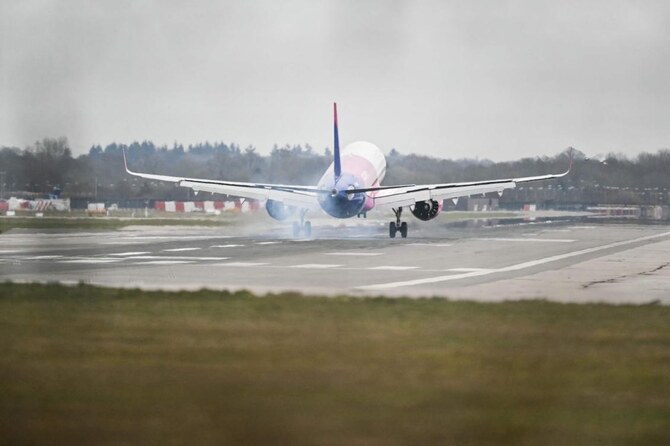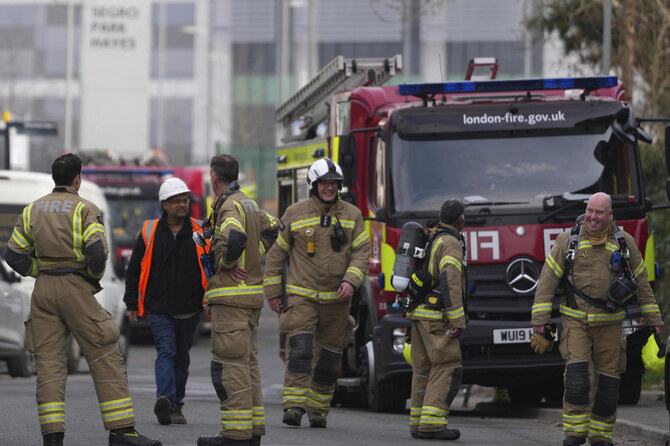LONDON: Heathrow Airport said it planned to resume some flights Friday after a large fire at an electrical substation knocked out power to Europe’s busiest flight hub and disrupted global travel for hundreds of thousands of passengers.
The London airport said it would begin flights for passengers stranded when their flights were diverted to other airports in Europe and to get airplanes back in the right place. It hopes to be in full operation on Saturday.
At least 1,350 flights to and from Heathrow were affected, flight tracking service FlightRadar 24 said, and the impact was likely to last several days as passengers try to reschedule their travel and airlines work to get planes and crew to the right places.
Authorities do not know what caused the fire but so far found have no evidence it was suspicious.
Residents in west London described hearing a large explosion, followed by a fireball and clouds of smoke, when the blaze ripped through the electrical substation near the airport.
Some 120 flights were in the air when the closure was announced, with some turned around and others diverted to Gatwick Airport outside London, Charles de Gaulle Airport near Paris or Ireland’s Shannon Airport, tracking services showed.
Lawrence Hayes was three-quarters of the way to London from New York when Virgin Atlantic announced they were being diverted to Glasgow.
“It was a red-eye flight and I’d already had a full day, so I don’t even know how long I’ve been up for,” Hayes told the BBC as he was getting off the plane in Scotland. “Luckily I managed to get hold of my wife and she’s kindly booked me a train ticket to get back to Euston, but it’s going to be an incredibly long day.”
Heathrow is one of the world’s busiest airports for international travel. It had its busiest January on record earlier this year, with more than 6.3 million passengers, up more than 5 percent from the same period last year.
Still, the disruption Friday fell short of the one caused by the 2010 eruption of Iceland’s Eyjafjallajokull volcano, which spewed clouds of ash into the atmosphere and created trans-Atlantic air travel chaos for months.
Unclear what caused the fire but foul play not suspected
It was too early to determine what sparked the huge blaze about 2 miles (3 kilometers) from the airport, but there’s “no suggestion” of foul play, Energy Secretary Ed Miliband said.
The Metropolitan Police force said counterterrorism detectives were leading the investigation because of their ability to find the cause quickly and because of the location of the electrical substation fire and its impact on critical national infrastructure.
Heathrow said its backup power supply designed for emergencies worked as expected, but it was not enough to run the whole airport. It said it had no choice but to close the airport for the day.
“We expect significant disruption over the coming days, and passengers should not travel to the airport under any circumstances until the airport reopens,” the airport said.
The widespread impact of the fire that took seven hours to control led to criticism that Britain was ill prepared for disaster or some type of attack if a single blaze could shut down Europe’s busiest airport.
“The UK’s critical national infrastructure is not sufficiently hardened for anywhere near the level it would need to be at to give us confidence this won’t happen again,” said Alan Mendoza, the executive director of the Henry Jackson Society, a security think tank. “If one fire can shut down Heathrow’s primary systems and then apparently the backup systems, as well, it tells you something’s badly wrong with our system of management of such disasters.”
Tom Wells, a spokesperson for Prime Minister Keir Starmer, acknowledged that authorities had questions to answer and said a rigorous investigation was needed to make sure “this scale of disruption does not happen again.”
Heathrow — where the UK government plans to build a third runway — was at the heart of a shorter disruption in 2023 when Britain’s air traffic control system was hit by a breakdown that slowed takeoffs and landings across the UK on one of the busiest travel days of the year.
Disruption could last days
Heathrow had said it expected to reopen Saturday, but that it anticipated “significant disruption over the coming days and passengers should not travel to the airport under any circumstances until the airport reopens.”
Even after the airport reopens, it will take several days to mobilize planes, cargo carriers, and crews and rebook passengers, said aviation consultant Anita Mendiratta.
“It’s not only about resuming with tomorrow’s flights, it’s the backlog and the implications that have taken place,” she said. “Crew and aircraft, many are not where they’re supposed to be right now. So the recalculation of this is going to be intense.”
The London Fire Brigade sent 10 engines and around 70 firefighters to control the blaze and about 150 people were evacuated from their homes near the power station.
Scottish and Southern Electricity Networks said in a post on X the power outage affected more than 16,300 homes.
Diverted, canceled and in limbo
At Heathrow, a family of five traveling to Dallas showed up in the hopes their flight home — still listed as delayed — would take off.
But when Andrea Sri brought her brother, sister-in-law and their three children to the airport, they were told by police that there would be no flight.
“It was a waste of time. Very confusing,” said Sri, who lives in London. “We tried to get in touch with British Airways, but they don’t open their telephone line until 8 a.m.”
Travelers who were diverted to other cities found themselves trying to book travel onward to London. Qantas airlines sent flights from Singapore and Perth, Australia, to Paris, where it said it would bus people to London, a process likely to also include a train shuttle beneath the English Channel.
Budget airline Ryanair, which doesn’t operate out of Heathrow, said it added eight “rescue flights” between Dublin and Stansted, another London airport, to transport stranded passengers Friday and Saturday.
National Rail canceled all trains to and from the airport.
Blaze lit up the sky and darkened homes
Matthew Muirhead was working Thursday night near Heathrow when he stepped outside with a colleague and noticed smoke rising from an electrical substation and heard sirens crying out.
“We saw a bright flash of white, and all the lights in town went out,” he said.
Flights normally begin landing and taking off at Heathrow at 6 a.m. due to nighttime flying restrictions. But the skies were silent Friday morning.
“Living near Heathrow is noisy, there are planes every 90 seconds or so, plus the constant hum of traffic, but you get used to it, to the point of no longer noticing,” said James Henderson, who has lived next to the airport for more than 20 years. “Today is different, you can hear the birds singing.”


Heathrow says some flights will resume after a fire cut power to Europe’s busiest airport
Short Url
https://arab.news/brc8z
Heathrow says some flights will resume after a fire cut power to Europe’s busiest airport

- The London airport said it would begin flights for passengers stranded when their flights were diverted to other airports in Europe and to get airplanes back in the right place
- At least 1,350 flights to and from Heathrow were affected, flight tracking service FlightRadar 24 said
Three killed in shelling of hospital in Russia-controlled Kherson, Russia-installed official says

- All those killed and injured were employees of the medical facility
MOSCOW: Three people were killed and two wounded by Ukrainian shelling of a hospital in the Russia-controlled part of Kherson region, a Russia-installed governor said on Telegram.
All those killed and injured were employees of the medical facility.
“The injured are receiving medical attention, and a seriously injured man is in intensive care,” Vladimir Saldo said.
© 2025 SAUDI RESEARCH & PUBLISHING COMPANY, All Rights Reserved And subject to Terms of Use Agreement.

















